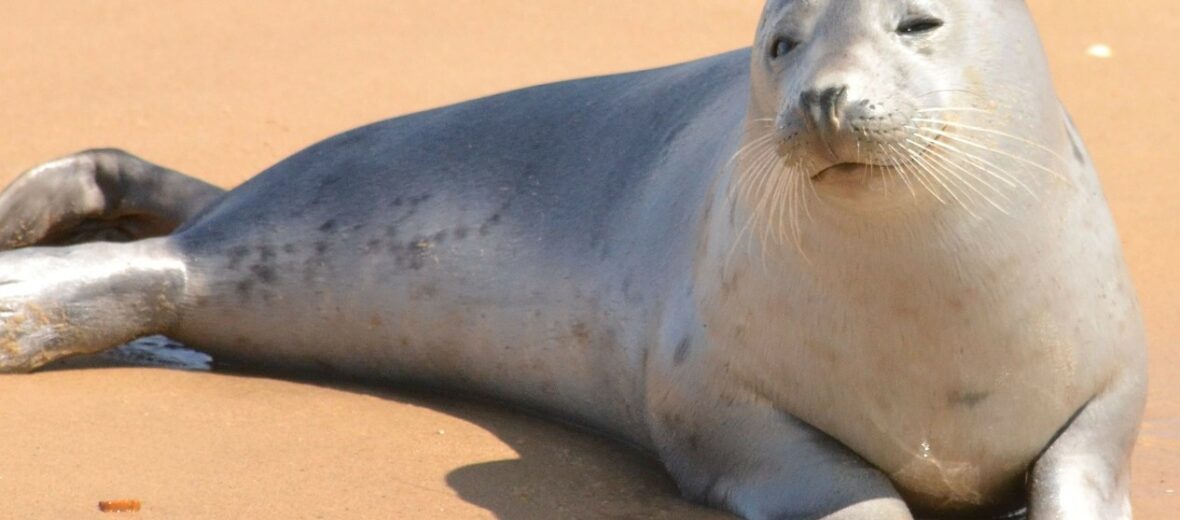
The harbor seal, aka common seal, is distributed throughout the northern Atlantic and Pacific Oceans, as well as the Baltic and Northern Seas. They typically reside in locations that are free of ice throughout the year. When resting or pupping (giving birth and rearing young) on land, they prefer mudflats, rocky islands, bays, sandy beaches, and estuaries. Harbor seals, like all seals, are pinnipeds. With approximately 315,000+ individuals in the wild, to date, these seals are listed as Least Concern by the IUCN.
First the Stats…
Scientific name: Phoca vitulina
Weight: Up to 285 lbs.
Length: Up to 5.3+ feet
Lifespan: Up to 30 years
Now on to the Facts!
1.) You wouldn’t know it by looking at them, but seals actually have long necks. They use this to their advantage, when they need to stretch out their neck and catch a fish.
2.) These seals can live in fresh and saltwater.
3.) Being typically non-migratory, these seals usually spend their entire lives in an area of about five square miles.
4.) Harbor seals have an excellent sense of hearing, especially while in the water.
5.) Their eyes are specially evolved to see well in murky water but don’t afford them good vision on land.
But wait, there’s more on the harbor seal!
6.) The harbor seal is typically solitary but will congregate in gregarious groups called harems, herds, pods, bobs, rookeries, or colonies during mating season.
7.) Their thick fur and blubber assist them with thermoregulation (balancing body temperature).
Did you know…?
These critters can swim at speeds of up to 12 mph.
8.) Pups can swim and dive for up to 2 minutes, just days after birth.
9.) These seals prey on herring, cod, mackerel, crustaceans, squid, and octopus. Shrimp are a very important part of young harbor seal pup diets.
10.) Harbor seals are polygynous (1 male mates with several females).
But wait, there’s still more on the harbor seal!
11.) They usually swallow their food whole or they will tear it into chunks with their rear molars. Then swallow the eviscerated chunks.
12.) Females birth a single pup each Spring, after up to an 11 month gestation (pregnancy).
Did you know…?
Harbor seals can stay underwater for up to 30 minutes, but typically only stay under for around 3 minutes at a time.
13.) In 4 – 6 weeks the pups are weaned and are expected to hunt on their own.
14.) Harbor seals can sleep on land or in the water. While in the water, they partake in what is called “bottling”. This is where their entire bodies remain under water and only their head is exposed. This allows them to breathe when needed.
15.) These seals can make deep dives as far as 1,400 feet!
But wait, there’s still a little more on the harbor seal!
16.) In Canada, some harbor seals are permanent residents in rivers and lakes.
17.) Unlike us humans, harbor seals always breathe out before diving underwater. They depend on the oxygen already in their blood stream and muscles to sustain them. Their heartbeat also slows from about 100 beats per minute to around 10.
18.) These critters are not very vocal, like other seals. Typically only the pups communicate vocally with mom, when they are hungry or lost.
19.) They tend to stick close to the shore for safety and to get onto land easier to warm themselves.
20.) In one breath a seal can exchange up to a whopping 90% of the air in their lungs. In contrast, humans can only exchange up to 20% of our oxygen intake per breath.
21.) Orcas, sea lions, sharks, polar bears, wolves, coyotes all prey on harbor seals. Bald eagles also sometimes take newborn pups.
Now a Short Harbor Seal Video!
Be sure to share & comment below! Also, check out the Critter Science YouTube channel. Videos added frequently!
Want to suggest a critter for me to write about? Let me know here.



